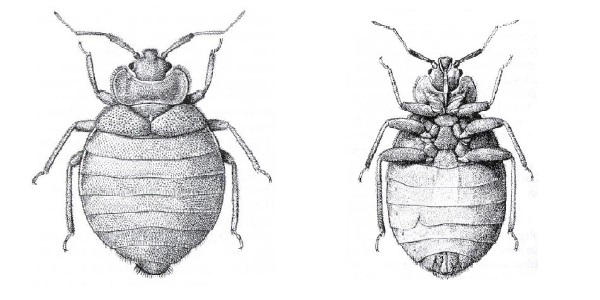Did you know?
Bed bugs have resurfaced as an important public health pest of not only housing institutions, hotels, and motels, but multiple and single family dwellings as well.
In the past, bed bug infestations were most often associated with transient housing, but several pest management companies have witnessed a significant increase in bed bug complaint calls from hotels and motels servicing the tourist trade in southern California. It is suspected that guests transport the bed bugs in luggage from previous accommodations, or introduce the pests with items brought from infested homes.
Although bed bugs are capable of harboring the causal agents of a number of diseases, research has not been able to document transmission of any disease agents during the feeding process. The principal medical importance of this pest is the welts, local inflammation, and itching caused by allergic reactions to the saliva that is introduced early in the act of feeding. Although some indi-viduals bitten by bed bugs have no reaction, others respond with considerable irritation at the site of the bite and suffer from irregular and restless sleep.
Bed bugs develop from egg to reproductive adult in as little as 37 days. This rapid life cycle, the ability of females to produce as many as 500 eggs during a lifetime, as well as their ability to endure prolonged starvation for periods of 80 to 140 days in the absence of a host, make them ideally suited to infestation of hotel and motel rooms of southern California.
Infestations can be introduced into single and multiple family dwellings in a number of different ways. Travelers can unknowingly bring the pest home in luggage after stay-ing in infested hotel and motel rooms. Bed bugs also stow away in furniture or boxes that are being moved from one site to another, or arrive in second-hand furniture or mattresses purchased from thrift shops or private parties.
Once in the home, bed bugs will find harborage in any convenient crack or crevice. In newly established infestations, bed bugs often harbor very close to beds and can be observed along the edge ribbing or beneath the buttons of mattresses, between the mattress and box spring, on the interior surface of the support frame, or behind the headboard. Other harborage sites used by bed bugs can be found in such places as behind or beneath baseboards, the area where wall-to-wall carpeting is attached at the floor/wall juncture, behind or under night stands or beneath the drawers, in the upholstery and frames of furniture, beneath decorator pillows, and behind wall hangings.
It is important to recognize the signs of a bed bug infestation. These pests are gregarious and nu-merous individuals may be found in convenient harborage sites, where clumps of small, yellowish eggs are often deposited, and the tarry black excrement may collect. Empty egg shells and cast skins are frequently observed in the immediate area.
Bed bug feeding wounds often bleed for a short period after the bug removes its mouth parts, resulting in speckles or streaks of blood on bed linens. This could be one of the first signs of a newly established infestation.

Eliminating bed bug infestations can be a difficult task. In multiple family dwellings, infestations can spread from one unit to another through wall voids where the pests can travel along water pipes and electrical wires. Under these circumstances, the successful abatement of the problem requires a cooperative effort between the management or property owners and an experienced pest management professional who has access to long-lasting pesticide formulations.
Bedbug infestations in single family dwellings should likewise be treated by an experienced pest management professional. If this is not feasible, it is possible to eliminate an infestation with pesticide products available to the general public. The key to effective control is finding all harborage areas. Closets and adjoining rooms should be considered as additional harborage sites.
Although readily available, liquid household pesticides will control bed bugs on contact and on surfaces for a short period after application, but will not provide effective residual control. Liquid pesticides should not be applied to the mattress. If a bulbous duster can be purchased, dusts such as boric acid or silica gel can be applied to the frame of the box spring mattress, into cracks and crevices, into wall voids through electrical and switch boxes, and along the wall/floor juncture. Dust formulations provide long-lasting residual control in these common harborage sites.
Thorough vacuuming of other possible harborage sites on a daily basis is extremely important. All furniture, upholstery, throw pillows, and draperies must be closely examined for bed bugs and thoroughly vacuumed. Remove bed linens and vacuum the surface of the mattress and box spring, checking closely for rips or tears which could provide additional harborage. Lift the box spring and vacuum the bed support frame and all surfaces of the headboard. Household cleansers should be used to eliminate any fecal spotting observed on solid surfaces, and pump or aerosol pesticides applied to these areas. Occupants should continue with these activities until no additional signs of bed bugs are observed and no new bites experienced.
If you have questions or concerns, or to report a problem, contact the Environmental Health Call Center at (888) 700-9995 or File a Complaint Online.